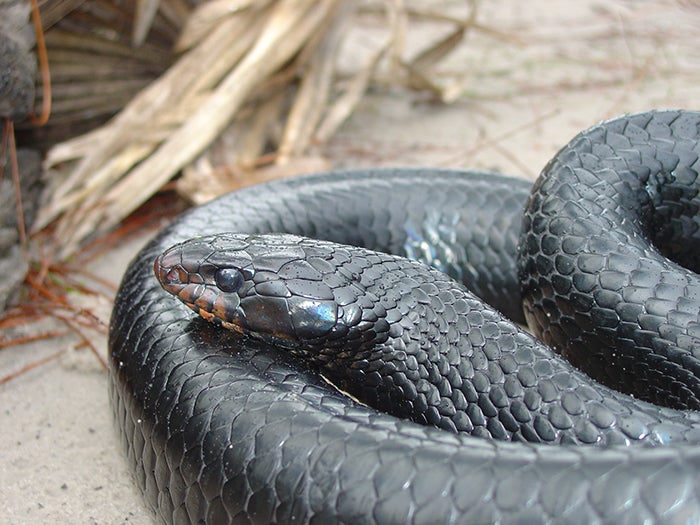Join a Celebration of North America’s Largest Nonvenomous Snake
The Indigo Snake and Wildlife Festival will be held at the Conecuh National Forest Open Pond Day Use Area located on Tower Road in Andalusia, Ala., on Friday, May 4, 2018. The event is open to school classes from 10 a.m. to 2 p.m. The public is invited to attend from 2:30 p.m. to 6 p.m. Admission is free.
During the event visitors can learn more about the threatened Eastern indigo snake, the local longleaf pine ecosystem, and gopher tortoises and the many species that benefit from their burrows. School groups and the public can also interact with animals and meet with wildlife biologists and foresters from various state, federal, and private conservation organizations.
The festival is hosted by the Alabama Wildlife and Freshwater Fisheries Division (WFF) in partnership with the U.S. Fish and Wildlife Service, U.S. Forest Service, and other partner conservation groups. The partners plan to hold the event annually.
To arrange for school class attendance, contact Charles Simon from the Covington County Extension Office at 334-222-1125. For general information about the festival, contact Traci Wood with WFF at Traci.Wood@dcnr.alabama.gov or 334-353-0503.
About the Eastern Indigo Snake
The Eastern indigo snake is a protected and threatened species throughout its historic range, which consists of southeast Mississippi, south Alabama, the Florida panhandle, and parts of south Georgia.
Decades of declining longleaf pine habitat in Alabama led to the disappearance of the snake from the state’s landscape. Prior to current reintroduction efforts, the last wild indigo snake observed in Alabama was in the 1950s.
The most notable features of the Eastern indigo snake are its iridescent, blue-black coloration and its impressive size. As the longest snake in North America, it can reach a length of more than 8 feet.
In recent years, WFF and other conservation groups have spearheaded an effort to reintroduce the nonvenomous Eastern indigo snake to the Conecuh National Forest in south Alabama.
Traci Wood, WFF State Wildlife Grants Coordinator, oversees the implementation of the reintroduction project.
“Most people wonder why we would want to reintroduce snakes back into the wild,” she said. “But the indigo snake serves an important ecological function and is an essential component of the longleaf pine landscape. It is at the top of the food chain and affects how well other animals manage.”
While its impressive size might seem intimidating, the Eastern indigo snake is a beneficial presence within the forest. In comparison to most other snakes, the indigo has a diet that includes venomous snakes such as copperheads and rattlesnakes.
As an apex predator, the indigo significantly contributes to the biodiversity of the forest by helping to maintain a healthy balance within the food chain – an indication of an ecologically functional forest.
“With this festival, we hope to share with the public the importance of the indigo snake,” Wood said. “Re-establishing the Eastern indigo within its historic range would also help restore a piece of Alabama’s natural history.”
The WFF State Wildlife Grants Program has a commitment to continue funding the indigo project over the next several years. This funding commitment is a step toward establishing a viable indigo population and addresses the recovery plan of the U.S. Fish and Wildlife Service.
To learn more about the Eastern indigo snake in Alabama, visit www.outdooralabama.com.
For information about the Conecuh National Forest, visit www.fs.usda.gov/alabama.
GPS Coordinates for the Open Pond Day Use Area: 31.0911538327, -86.5456207044.
The Alabama Department of Conservation and Natural Resources promotes wise stewardship, management and enjoyment of Alabama’s natural resources through four divisions: Marine Resources, State Lands, State Parks, and Wildlife and Freshwater Fisheries. To learn more about ADCNR, visit www.outdooralabama.com.
###






